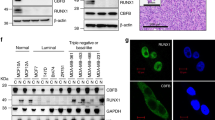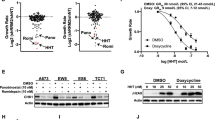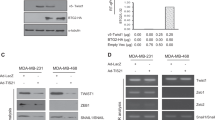Abstract
RNA-binding proteins play a key role in post-transcriptional regulation of mRNA stability and translation. We have identified that RBM3, a translation regulatory protein, is significantly upregulated in human tumors, including a stage-dependent increase in colorectal tumors. Forced RBM3 overexpression in NIH3T3 mouse fibroblasts and SW480 human colon epithelial cells increases cell proliferation and development of compact multicellular spheroids in soft agar suggesting the ability to induce anchorage-independent growth. In contrast, downregulating RBM3 in HCT116 colon cancer cells with specific siRNA decreases cell growth in culture, which was partially overcome when treated with prostaglandin E2, a product of cyclooxygenase (COX)-2 enzyme activity. Knockdown also resulted in the growth arrest of tumor xenografts. We have also identified that RBM3 knockdown increases caspase-mediated apoptosis coupled with nuclear cyclin B1, and phosphorylated Cdc25c, Chk1 and Chk2 kinases, implying that under conditions of RBM3 downregulation, cells undergo mitotic catastrophe. RBM3 enhances COX-2, IL-8 and VEGF mRNA stability and translation. Conversely, RBM3 knockdown results in loss in the translation of these transcripts. These data demonstrate that the RNA stabilizing and translation regulatory protein RBM3 is a novel proto-oncogene that induces transformation when overexpressed and is essential for cells to progress through mitosis.
This is a preview of subscription content, access via your institution
Access options
Subscribe to this journal
Receive 50 print issues and online access
$259.00 per year
only $5.18 per issue
Buy this article
- Purchase on Springer Link
- Instant access to full article PDF
Prices may be subject to local taxes which are calculated during checkout






Similar content being viewed by others
Accession codes
References
Andreis PG, Whitfield JF, Armato U . (1981). Stimulation of DNA synthesis and mitosis of hepatocytes in primary cultures of neonatal rat liver by arachidonic acid and prostaglandins. Exp Cell Res 134: 265–272.
Blaxall BC, Dwyer-Nield LD, Bauer AK, Bohlmeyer TJ, Malkinson AM, Port JD . (2000). Differential expression and localization of the mRNA binding proteins, AU-rich element mRNA binding protein (AUF1) and Hu antigen R (HuR), in neoplastic lung tissue. Mol Carcinog 28: 76–83.
Bulavin DV, Amundson SA, Fornace AJ . (2002). p38 and Chk1 kinases: different conductors for the G(2)/M checkpoint symphony. Curr Opin Genet Dev 12: 92–97.
Canman CE . (2001). Replication checkpoint: preventing mitotic catastrophe. Curr Biol 11: R121–R124.
Carpenter B, McKay M, Dundas SR, Lawrie LC, Telfer C, Murray GI . (2006). Heterogeneous nuclear ribonucleoprotein K is over expressed, aberrantly localised and is associated with poor prognosis in colorectal cancer. Br J Cancer 95: 921–927.
Chen CY, Shyu AB . (1995). AU-rich elements: characterization and importance in mRNA degradation. Trends Biochem Sci 20: 465–470.
Chen CY, Xu N, Shyu AB . (1995). mRNA decay mediated by two distinct AU-rich elements from c-fos and granulocyte-macrophage colony-stimulating factor transcripts: different deadenylation kinetics and uncoupling from translation. Mol Cell Biol 15: 5777–5788.
Chen YQ, Hsieh JT, Yao F, Fang B, Pong RC, Cipriano SC et al. (1999). Induction of apoptosis and G2/M cell cycle arrest by DCC. Oncogene 18: 2747–2754.
Cok SJ, Morrison AR . (2001). The 3′-untranslated region of murine cyclooxygenase-2 contains multiple regulatory elements that alter message stability and translational efficiency. J Biol Chem 276: 23179–23185.
Danno S, Nishiyama H, Higashitsuji H, Yokoi H, Xue JH, Itoh K et al. (1997). Increased transcript level of RBM3, a member of the glycine-rich RNA-binding protein family, in human cells in response to cold stress. Biochem Biophys Res Commun 236: 804–807.
Denkert C, Koch I, von Keyserlingk N, Noske A, Niesporek S, Dietel M et al. (2006). Expression of the ELAV-like protein HuR in human colon cancer: association with tumor stage and cyclooxygenase-2. Mod Pathol 19: 1261–1269.
Denkert C, Weichert W, Winzer KJ, Muller BM, Noske A, Niesporek S et al. (2004). Expression of the ELAV-like protein HuR is associated with higher tumor grade and increased cyclooxygenase-2 expression in human breast carcinoma. Clin Cancer Res 10: 5580–5586.
Derry JM, Kerns JA, Francke U . (1995). RBM3, a novel human gene in Xp11.23 with a putative RNA-binding domain. Hum Mol Genet 4: 2307–2311.
Deschenes-Furry J, Belanger G, Mwanjewe J, Lunde JA, Parks RJ, Perrone-Bizzozero N et al.. (2005). The RNA-binding protein HuR binds to acetylcholinesterase transcripts and regulates their expression in differentiating skeletal muscle cells. J Biol Chem 280: 25361–25368.
Dixon DA, Kaplan CD, McIntyre TM, Zimmerman GA, Prescott SM . (2000). Post-transcriptional control of cyclooxygenase-2 gene expression. The role of the 3′-untranslated region. J Biol Chem 275: 11750–11757.
Dixon DA, Tolley ND, King PH, Nabors LB, McIntyre TM, Zimmerman GA et al. (2001). Altered expression of the mRNA stability factor HuR promotes cyclooxygenase-2 expression in colon cancer cells. J Clin Invest 108: 1657–1665.
Doree M, Hunt T . (2002). From Cdc2 to Cdk1: when did the cell cycle kinase join its cyclin partner? J Cell Sci 115: 2461–2464.
Dresios J, Aschrafi A, Owens GC, Vanderklish PW, Edelman GM, Mauro VP . (2005). Cold stress-induced protein Rbm3 binds 60S ribosomal subunits, alters microRNA levels, and enhances global protein synthesis. Proc Natl Acad Sci USA 102: 1865–1870.
Dubois RN, Abramson SB, Crofford L, Gupta RA, Simon LS, Van De Putte LB et al. (1998). Cyclooxygenase in biology and disease. FASEB J 12: 1063–1073.
Eberhart CE, Coffey RJ, Radhika A, Giardiello FM, Ferrenbach S, DuBois RN . (1994). Up-regulation of cyclooxygenase 2 gene expression in human colorectal adenomas and adenocarcinomas. Gastroenterology 107: 1183–1188.
Erkinheimo TL, Lassus H, Sivula A, Sengupta S, Furneaux H, Hla T et al. (2003). Cytoplasmic HuR expression correlates with poor outcome and with cyclooxygenase 2 expression in serous ovarian carcinoma. Cancer Res 63: 7591–7594.
Erkinheimo TL, Sivula A, Lassus H, Heinonen M, Furneaux H, Haglund C et al. (2005). Cytoplasmic HuR expression correlates with epithelial cancer cell but not with stromal cell cyclooxygenase-2 expression in mucinous ovarian carcinoma. Gynecol Oncol 99: 14–19.
Fan XC, Steitz JA . (1998a). HNS, a nuclear-cytoplasmic shuttling sequence in HuR. Proc Natl Acad Sci USA 95: 15293–15298.
Fan XC, Steitz JA . (1998b). Overexpression of HuR, a nuclear-cytoplasmic shuttling protein, increases the in vivo stability of ARE-containing mRNAs. EMBO J 17: 3448–3460.
Hacker S, Krebber H . (2004). Differential export requirements for shuttling serine/arginine-type mRNA-binding proteins. J Biol Chem 279: 5049–5052.
Heinonen M, Bono P, Narko K, Chang SH, Lundin J, Joensuu H et al. (2005). Cytoplasmic HuR expression is a prognostic factor in invasive ductal breast carcinoma. Cancer Res 65: 2157–2161.
Krysan K, Reckamp KL, Dalwadi H, Sharma S, Rozengurt E, Dohadwala M et al. (2005). Prostaglandin E2 activates mitogen-activated protein kinase/Erk pathway signaling and cell proliferation in non-small cell lung cancer cells in an epidermal growth factor receptor-independent manner. Cancer Res 65: 6275–6281.
Landegren U . (1984). Measurement of cell numbers by means of the endogenous enzyme hexosaminidase. Applications to detection of lymphokines and cell surface antigens. J Immunol Methods 67: 379–388.
Landen Jr CN, Chavez-Reyes A, Bucana C, Schmandt R, Deavers MT, Lopez-Berestein G et al. (2005). Therapeutic EphA2 gene targeting in vivo using neutral liposomal small interfering RNA delivery. Cancer Res 65: 6910–6918.
Lopez de Silanes I, Fan J, Yang X, Zonderman AB, Potapova O, Pizer ES et al. (2003). Role of the RNA-binding protein HuR in colon carcinogenesis. Oncogene 22: 7146–7154.
Maller JL . (1991). Mitotic control. Curr Opin Cell Biol 3: 269–275.
Millar JB, Russell P . (1992). The cdc25 M-phase inducer: an unconventional protein phosphatase. Cell 68: 407–410.
Mukhopadhyay D, Houchen CW, Kennedy S, Dieckgraefe BK, Anant S . (2003a). Coupled mRNA stabilization and translational silencing of cyclooxygenase-2 by a novel RNA binding protein, CUGBP2. Mol Cell 11: 113–126.
Mukhopadhyay D, Jung J, Murmu N, Houchen CW, Dieckgraefe BK, Anant S . (2003b). CUGBP2 plays a critical role in apoptosis of breast cancer cells in response to genotoxic injury. Ann N Y Acad Sci 1010: 504–509.
Munkarah AR, Morris R, Baumann P, Deppe G, Malone J, Diamond MP et al. (2002). Effects of prostaglandin E(2) on proliferation and apoptosis of epithelial ovarian cancer cells. J Soc Gynecol Investig 9: 168–173.
Myer VE, Fan XC, Steitz JA . (1997). Identification of HuR as a protein implicated in AUUUA-mediated mRNA decay. EMBO J 16: 2130–2139.
Nabors LB, Gillespie GY, Harkins L, King PH . (2001). HuR, a RNA stability factor, is expressed in malignant brain tumors and binds to adenine- and uridine-rich elements within the 3′ untranslated regions of cytokine and angiogenic factor mRNAs. Cancer Res 61: 2154–2161.
Ning S, Knox SJ . (1999). G2/M-phase arrest and death by apoptosis of HL60 cells irradiated with exponentially decreasing low-dose-rate gamma radiation. Radiat Res 151: 659–669.
Ohi R, Gould KL . (1999). Regulating the onset of mitosis. Curr Opin Cell Biol 11: 267–273.
Peng SS, Chen CY, Xu N, Shyu AB . (1998). RNA stabilization by the AU-rich element binding protein, HuR, an ELAV protein. EMBO J 17: 3461–3470.
Pinol-Roma S . (1997). HnRNP proteins and the nuclear export of mRNA. Semin Cell Dev Biol 8: 57–63.
Ristimaki A, Narko K, Hla T . (1996). Down-regulation of cytokine-induced cyclo-oxygenase-2 transcript isoforms by dexamethasone: evidence for post-transcriptional regulation. Biochem J 318 (Pt 1): 325–331.
Shao J, Lee SB, Guo H, Evers BM, Sheng H . (2003). Prostaglandin E2 stimulates the growth of colon cancer cells via induction of amphiregulin. Cancer Res 63: 5218–5223.
Sheng H, Shao J, Morrow JD, Beauchamp RD, DuBois RN . (1998). Modulation of apoptosis and Bcl-2 expression by prostaglandin E2 in human colon cancer cells. Cancer Res 58: 362–366.
Sheng H, Shao J, Washington MK, DuBois RN . (2001). Prostaglandin E2 increases growth and motility of colorectal carcinoma cells. J Biol Chem 276: 18075–18081.
Shyu AB, Wilkinson MF . (2000). The double lives of shuttling mRNA binding proteins. Cell 102: 135–138.
Smart F, Aschrafi A, Atkins A, Owens GC, Pilotte J, Cunningham BA et al. (2007). Two isoforms of the cold-inducible mRNA-binding protein RBM3 localize to dendrites and promote translation. J Neurochem 101: 1367–1379.
Stark GR, Taylor WR . (2004). Analyzing the G2/M checkpoint. Methods Mol Biol 280: 51–82.
Sureban SM, Murmu N, Rodriguez P, May R, Maheshwari R, Dieckgraefe BK et al. (2007). Functional antagonism between RNA binding proteins HuR and CUGBP2 determines the fate of COX-2 mRNA translation. Gastroenterology 132: 1055–1065.
Sutherland LC, Rintala-Maki ND, White RD, Morin CD . (2005). RNA binding motif (RBM) proteins: a novel family of apoptosis modulators? J Cell Biochem 94: 5–24.
Taylor WR, Stark GR . (2001). Regulation of the G2/M transition by p53. Oncogene 20: 1803–1815.
Wahl AF, Donaldson KL, Fairchild C, Lee FY, Foster SA, Demers GW et al. (1996). Loss of normal p53 function confers sensitization to Taxol by increasing G2/M arrest and apoptosis. Nat Med 2: 72–79.
Walworth NC . (2001). DNA damage: Chk1 and Cdc25, more than meets the eye. Curr Opin Genet Dev 11: 78–82.
Wang D, Mann JR, DuBois RN . (2005). The role of prostaglandins and other eicosanoids in the gastrointestinal tract. Gastroenterology 128: 1445–1461.
Wu G, Yi J, Di F, Zou S, Li X . (2005). Celecoxib inhibits proliferation and induces apoptosis via cyclooxygenase-2 pathway in human pancreatic carcinoma cells. J Huazhong Univ Sci Technolog Med Sci 25: 42–44.
Yamashita H, Osaki M, Honjo S, Yoshida H, Teshima R, Ito H . (2003). A selective cyclooxygenase-2 inhibitor, NS-398, inhibits cell growth by cell cycle arrest in a human malignant fibrous histiocytoma cell line. Anticancer Res 23: 4671–4676.
Acknowledgements
We thank Stephen Prescott for helpful suggestions and Joan Steitz for the Flag-HuR plasmid. This work was supported by NIH Grants DK-62265 and CA-109269.
Author information
Authors and Affiliations
Corresponding author
Additional information
Supplementary Information accompanies the paper on the Oncogene website (http://www.nature.com/onc).
Supplementary information
Rights and permissions
About this article
Cite this article
Sureban, S., Ramalingam, S., Natarajan, G. et al. Translation regulatory factor RBM3 is a proto-oncogene that prevents mitotic catastrophe. Oncogene 27, 4544–4556 (2008). https://doi.org/10.1038/onc.2008.97
Received:
Revised:
Accepted:
Published:
Issue Date:
DOI: https://doi.org/10.1038/onc.2008.97
Keywords
This article is cited by
-
Development and validation of an RBP gene signature for prognosis prediction in colorectal cancer based on WGCNA
Hereditas (2023)
-
RBM3 is associated with acute lung injury in septic mice and patients via the NF-κB/NLRP3 pathway
Inflammation Research (2023)
-
RNA-binding protein RBM3 intrinsically suppresses lung innate lymphoid cell activation and inflammation partially through CysLT1R
Nature Communications (2022)
-
RNA binding motif protein 3 (RBM3) promotes protein kinase B (AKT) activation to enhance glucose metabolism and reduce apoptosis in skeletal muscle of mice under acute cold exposure
Cell Stress and Chaperones (2022)
-
Mild Hypothermia Prevents NO-Induced Cytotoxicity in Human Neuroblastoma Cells Via Induction of COX-2
Journal of Molecular Neuroscience (2019)



